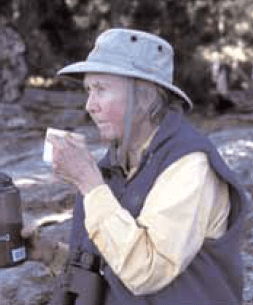Preserving the Quetico Wilderness through Writing, Teaching, Mentoring

Shirley Peruniak answered the phone one early April afternoon at her home in
Sharbot Lake, Ontario, and agreed to talk about her life and her recently published
book, Quetico Provincial Park: An Illustrated History. But first, she was intent on
describing a bird she’d been watching.
“I’m looking out my window right now, and I think it’s an immature trumpeter swan,” said the bird enthusiast, who served as Quetico’s Assistant Park Naturalist from 1979 to 1991. “I called everybody to come over and see it and I got out the telescope.”
It was easy to see how Peruniak, the garrulous bird enthusiast, was able to get people talking about the park and themselves. Over the years, those conversations turned into 300 hours of taped interviews – the foundation
material for her book.
Although she has been “retired” for a decade, Peruniak apparently hasn’t slowed down or lost one iota of
her enthusiasm for nature and wilderness protection. Every summer, she returns to Quetico Provincial Park
as a volunteer to entertain and educate visitors with colorful stories and details about the park’s history and
inhabitants. She has a lot of material to draw upon – 15,000 slides and the taped interviews collected during
her years as a park staffer. Some of these aren’t yet catalogued and transcribed, and she said she’s found it’s
fastest if she does this work herself. She also continues to conduct the park’s breeding bird census, which she
launched more than 40 years ago.
Peruniak grew up in Sharbot Lake, nearly 1,000 miles from Quetico Provincial Park. She and her husband
were schoolteachers. Her first canoe trip in the park in 1956 inspired them to move to Atikokan three
years later with their two children. “I enjoyed the park work so much more,” she said. “People came to the
park because they wanted to, while students go to school because they have to.”
Today, as a Quetico volunteer, Peruniak still canoes to her little cabin on Nim Lake, often with one of her
two children, both of whom live elsewhere in Canada. And she continues to collaborate with the people of the
Lac La Croix First Nation on a Quetico history project from the Ojibwe perspective. Federal grants have made
it possible for Ojibwe students to canoe the park with Peruniak, study the information she collected over the
years and then interview their elders and begin creating history albums from their people’s perspective.
Peruniak’s illustrated history, published in 2000 by the Friends of Quetico Park, combines a chronology
of historical events spanning the 18th, 19th and 20th centuries with descriptions of natural beauty and a
photo album and anecdotes about the park superintendents, rangers and some of Quetico’s colorful residents
and visitors. Peruniak said the enthusiastic response of current and former park staffers to the book
has been “wonderful.”
“Protecting wilderness is one of the hardest things there is; it’s an ongoing struggle,” Peruniak said. “The
numbers of people are an incredible thing to try to cope with. Fortunately in Quetico, we got a (visitor) quota
system before the numbers got too big. Now there’s a motor boat ban, which is a step in the right direction.
Restricting group size is a difficult issue, because you want young people to have an enjoyable experience. You
need good leadership for the youth camp groups.”
She recalled one spectacular morning on Argo Lake with a group of Ojibwe children, remarking how
each member of the group was in awe of the beauty surrounding them. “Those are the treasures you hope
people can experience.”
– Diane Rose, Wilderness News Contributor

